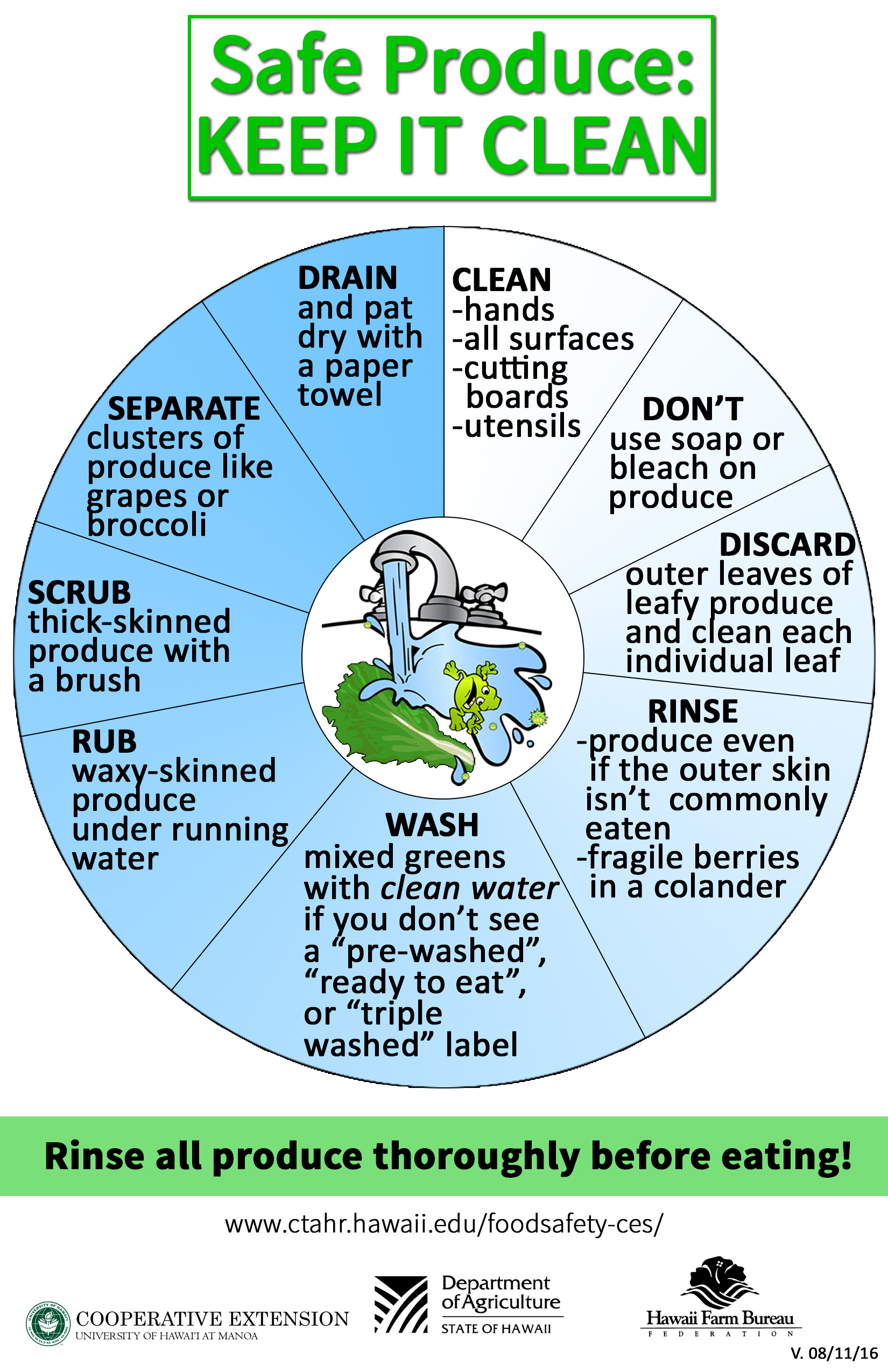Our education team and colleagues have developed a number of publications to address the information needs of producers, manufacturers, and consumers as it pertains to on-farm and general food safety. The below publications are arranged A-Z.
Quick tips for washing produce. Click the icon to view and download this handout.
Clear information about what non-synthetic and synthetic fertilizer and pesticide products can be used on USDA Certified Organic farms.
A Farmer’s Guide to Biological, Chemical, and Physical Food Adulteration
Learn what food adulteration is and how to avoid it. That’s risk reduction!
Avoid Contracting Angiostrongyliasis (Rat Lungworm Infection): Wash Fresh Fruits and Vegetables Before Eating!
This consumer information is more focused on what to do for home cooks after a product is harvested.
Best food-safety practices for Hawai‘i gardeners
Some hints about how to do gardening safer from a food perspective.
Best on-farm food safety practices: Documenting trace-back and trace-forward of harvested produce
It is critical during an outbreak that investigators can reach back to a farm as quickly as possible. This document explains how that works and provides a simple trace-back tagging system.
Best On-Farm Food Safety Practices: Reducing Risks Associated with Rat Lungworm Infection and Human Eosinophilic Meningitis
It is important to manage rats, slugs and snails on farms and gardens in Hawai‘i.
Box labeling
In order to meet both the Perishable Agricultural Commodities Act and the need for trace-back, this document provides some guidance on basic labeling.
Farm food safety behavior signs
This custom set of signs was developed to address some of the standard operating procedures on a third-party ranch or farm audit.
Food Safety Modernization Act – Produce Rule decision tree
Read a very simple decision tree on Sec 105, The Produce Rule as it appears before the Final Rule is released between 2014-2015. Final Rule Published!
Good agricultural practices (GAP): a consumer discovery tool for learning about risk-reducing behaviors on commercial farms and in school gardens
Learn about what GAP are in lay person terms. Take our Cosmo-like GAP discovery survey!
Good food safety practices: managing risks to reduce or avoid legal liability
Many growers don’t realize that, just like other companies, they can be liable for the quality and safety of the product they sell. A Honolulu-based attorney provides an overview of this responsibility.
Hawai‘i’s Federally Subsidized Public School Lunch Program and the Hawai‘i Department of Education’s Food Safety Requirements for It
Hawai‘i has one of the three largest single-district school food service programs in the U.S. with over 100,000 lunches served each day. In order to receive reimbursement from the Federal government for food purchases, the Hawai‘i Department of Education’s Food Service Branch, must follow specific guidelines. General overviews of those guidelines are included here.
Produce labeling: using tea as an example (Required and Optional Labeling for Loose Tea for Sale)
Informing consumers about what’s in your package is both a legal responsibility and a good marking tactic. This document will give you some basics.
Produce processing: using tea as an example (Some Minimum Physical Requirements* for a Commercial- Scale Dried Loose Leaf Tea-Processing Facility in Hawai‘i)
If you are processing, more than just “packing”, you need to do it in compliance with Hawai‘i Department of Health and US FDA requirements. This document uses tea to provide a basic template on what is required.
On-farm food safety: Aquaponics
The blending of fish and produce creates some unique opportunities. It also requires that certain best practices be used to reduce the risk of cross-contamination.
A Preliminary Study of Microbial Water Quality Related to Food Safety in Recirculating Aquaponic Fish and Vegetable Production Systems
A recent study of what could be in aquaponics water.
On-farm food safety: Questions growers frequently ask
A summary of relevant frequently asked questions
Student and food safety: Best practices for Hawai‘i school gardens
Up-to-date information on how to operate a school garden under best practices.
Pest management systems to control rodents in and around packing sheds
Managing rodent populations is critical to keeping up Good Agricultural Practices. This document outlines typical requirements found on audits.
Pesticide education twin wall charts for Hawai‘i farms
Innovative, accurate, and attractive, two 42″x36 wall charts cover EPA Worker Protection Standard requirements, and best practices for non-organic and organic pesticide handlers/applicators. This chart set reinforces that, “the label is the law,” when it comes to pesticide use regardless if it is non-organic or organic. Included on the handler chart is the 128th Method for easy sprayer calibration. Charts can ONLY be picked up at Hawai‘i Department of Agriculture offices throughout the islands – NO MAILING.
Pesticide Education Kit
Knowing the law, how to pick the proper nozzle, how to keep yourself and your workers safety from pesticides, how to inventory your pesticides, and finally, how to record their use, is what makes up this innovative education kit for pesticide users.
The Produce Traceability Initiative (PTI): A Primer for Hawai‘i’s Small-Farm Operators
The future is here – every box of produce will be labelled for rapid trace-back to a field. Learn more here.
Great food safety pubs from other writers
Hawai‘i Department of Health’s Basic Good Food Handling Practices
Simple and clear advice for retail food establishments – but, are good reminders for farmers and packers.
On-farm GAP from Penn State
A nice simple brochure that covers the basics of GAPS.
On-farm Food Safety: Cleaning and Sanitizing Guide
Iowa State University’s handy and informative guide on surface sanitation techniques.

